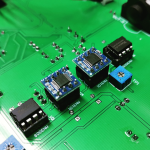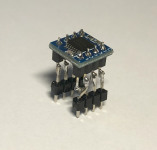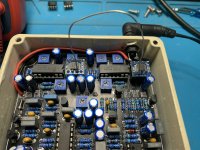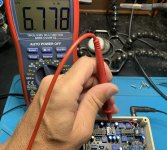Cabintech
Authorized Vendor
Hi all, we have developed a simple drop-in replacement for the MN3101 BBD clock chip for use with MN300X series BBDs. The CT3101 is a small PCB with the same DIL-8 footprint and same pinout as the MN3101. It is based on the CD4047 and includes the Vgg (14/15 Vdd) output voltage, and supports supply voltages to -18V.
It has been bench-tested and verified in a few products (including the MOE AC60, photo below, and Juno 106) but we are seeking beta testers who would be willing to try these in a wide variety of devices to make sure they work in various operating conditions and circuit designs. Ideally, when swapped with an MN3101 there would be no discernable difference in sound or function.
Here is a photo of the CT3101 modules in sockets along side two MN3009s in the AC60:

If you are interested in giving these a try, we will send you 2 prototype samples at no cost. We only ask that you try them in devices that currently use MN3101 chips and report back to us what device you put them in, and how they worked or any problems you noticed. (If you need more than 2 let us know, we have a limited prototype supply). You are welcome to post your results here or (if your design is confidential) by email or PM. We would be particularly interested in flangers (see design notes below).
Send us a PM with your shipping address and what device(s) you will be testing and we will ship them to you in the next few days.
Thanks!
Mark McMillan
Cabintech Global LLC
Background:
For years customers have been asking us to sell MN3101 chips or help them find a reliable supply. As a policy, we prefer not to deal in so-called "New Old Stock" (NOS) devices (although we did for a while during the pandemic/chip shortage). Always we told them, the MN3101 is long out of production and there is no current clone manufacturer... we don't carry the MN3101 and good luck finding ones that are not fake or have high fall-out rates. You might get lucky on Ebay and find one that works. A number of alternatives are available to produce the required BBD 2-phase clocks, but that does not help someone trying to repair an existing device or build a kit designed for the 3101.
It did not seem so hard to make a clone, the concepts of a multivibrator circuit are well understood. So finally we started down the path of a new chip design (it is not particularly difficult), but then the chip shortage hit and we had to abandon that idea. Also the quantities needed to make them cost effective were quite high. So instead we considered a hybrid module (PCB with a DIL-8 footprint and pinout identical to the MN3101). These are easy to manufacturer in reasonable quantities and allow us to use inexpensive off-the-shelf parts instead of a custom chip design. This idea sat on the shelf for a while until Made On Earth needed some BBD chips and mentioned they were having trouble sourcing the 3101s needed to make them work. So we collaborated with them on a design for the CT3101 and we recently verified it in their AC60 analog chorus pedal design. It has also been verified in the Juno 106 (and presumably, the similar Juno 6 and 60).
The Design:
The CT3101 design is quite simple, it is a CD4047 with a decoupling cap and a voltage divider network (to generate Vgg output). Because the CD4047 is a +V device, ground and power on the PCB are reversed relative to the MN3101 Vdd/GND pins. The PCB contains the interconnect to configure the CD4047 and route inputs and outputs to the MN3101 pinout. The 8 DIL pins are not common header pins that are often too big to fit into DIP sockets, but smaller round pins that allow the module to be socketed easily or soldered in through-hole designs. The PCB is slightly larger than an actual MN3101 DIL package so it may be a tight mechanical fit in very crowded system designs if other components are very close to the MN3101.
There is no output driver, so output current is limited to what the CD4047 can source. This may prove problematic at high frequencies, we don't know yet if it is a practical issue in real high frequency designs (e.g. flangers).
It has been bench-tested and verified in a few products (including the MOE AC60, photo below, and Juno 106) but we are seeking beta testers who would be willing to try these in a wide variety of devices to make sure they work in various operating conditions and circuit designs. Ideally, when swapped with an MN3101 there would be no discernable difference in sound or function.
Here is a photo of the CT3101 modules in sockets along side two MN3009s in the AC60:

If you are interested in giving these a try, we will send you 2 prototype samples at no cost. We only ask that you try them in devices that currently use MN3101 chips and report back to us what device you put them in, and how they worked or any problems you noticed. (If you need more than 2 let us know, we have a limited prototype supply). You are welcome to post your results here or (if your design is confidential) by email or PM. We would be particularly interested in flangers (see design notes below).
Send us a PM with your shipping address and what device(s) you will be testing and we will ship them to you in the next few days.
Thanks!
Mark McMillan
Cabintech Global LLC
Background:
For years customers have been asking us to sell MN3101 chips or help them find a reliable supply. As a policy, we prefer not to deal in so-called "New Old Stock" (NOS) devices (although we did for a while during the pandemic/chip shortage). Always we told them, the MN3101 is long out of production and there is no current clone manufacturer... we don't carry the MN3101 and good luck finding ones that are not fake or have high fall-out rates. You might get lucky on Ebay and find one that works. A number of alternatives are available to produce the required BBD 2-phase clocks, but that does not help someone trying to repair an existing device or build a kit designed for the 3101.
It did not seem so hard to make a clone, the concepts of a multivibrator circuit are well understood. So finally we started down the path of a new chip design (it is not particularly difficult), but then the chip shortage hit and we had to abandon that idea. Also the quantities needed to make them cost effective were quite high. So instead we considered a hybrid module (PCB with a DIL-8 footprint and pinout identical to the MN3101). These are easy to manufacturer in reasonable quantities and allow us to use inexpensive off-the-shelf parts instead of a custom chip design. This idea sat on the shelf for a while until Made On Earth needed some BBD chips and mentioned they were having trouble sourcing the 3101s needed to make them work. So we collaborated with them on a design for the CT3101 and we recently verified it in their AC60 analog chorus pedal design. It has also been verified in the Juno 106 (and presumably, the similar Juno 6 and 60).
The Design:
The CT3101 design is quite simple, it is a CD4047 with a decoupling cap and a voltage divider network (to generate Vgg output). Because the CD4047 is a +V device, ground and power on the PCB are reversed relative to the MN3101 Vdd/GND pins. The PCB contains the interconnect to configure the CD4047 and route inputs and outputs to the MN3101 pinout. The 8 DIL pins are not common header pins that are often too big to fit into DIP sockets, but smaller round pins that allow the module to be socketed easily or soldered in through-hole designs. The PCB is slightly larger than an actual MN3101 DIL package so it may be a tight mechanical fit in very crowded system designs if other components are very close to the MN3101.
There is no output driver, so output current is limited to what the CD4047 can source. This may prove problematic at high frequencies, we don't know yet if it is a practical issue in real high frequency designs (e.g. flangers).







